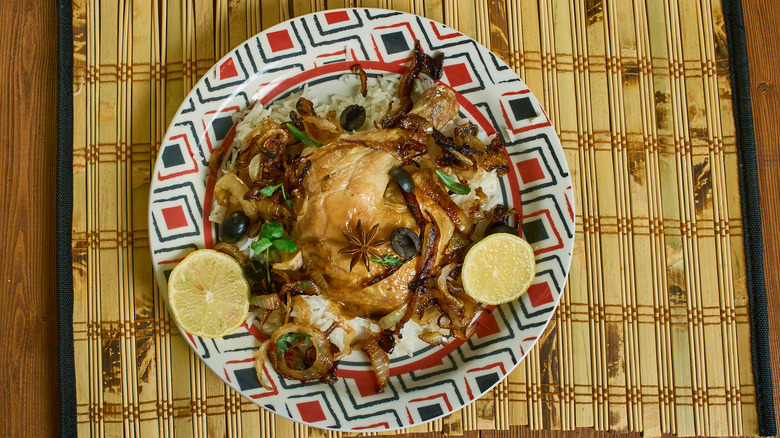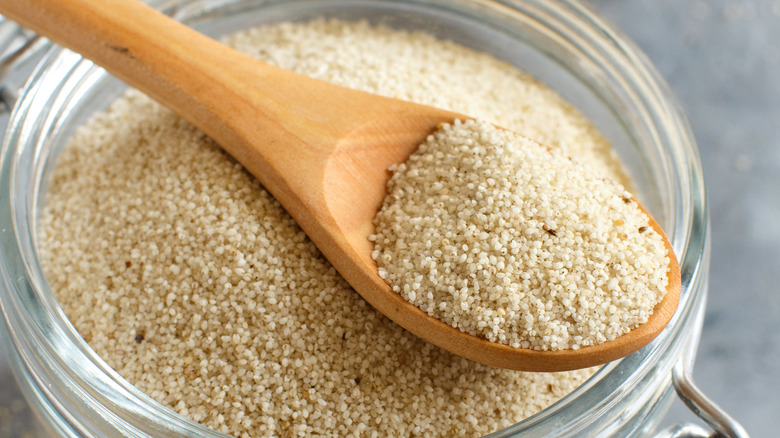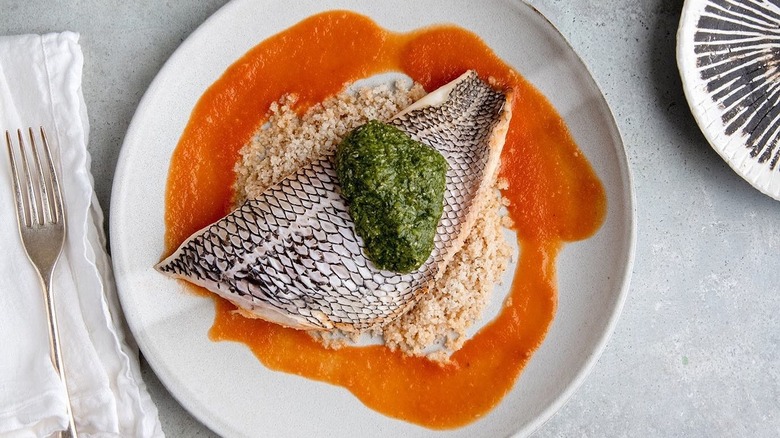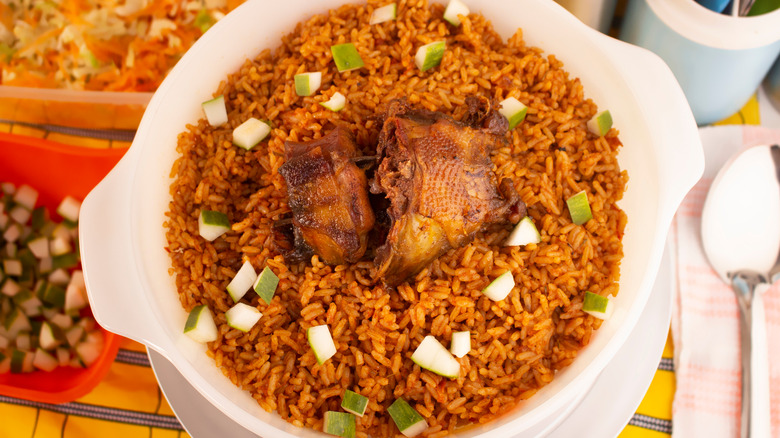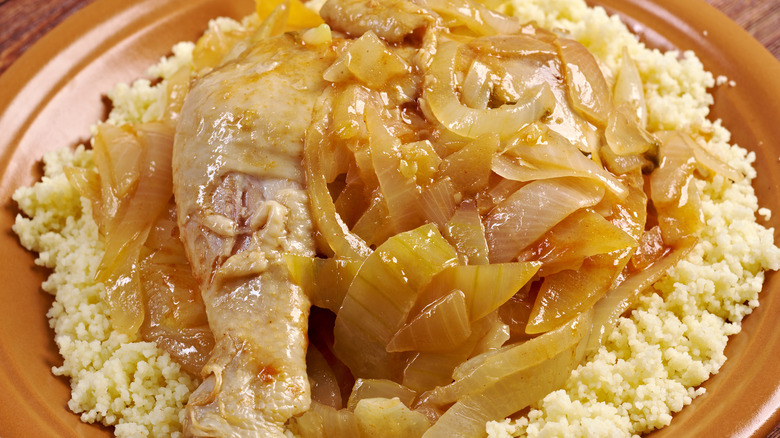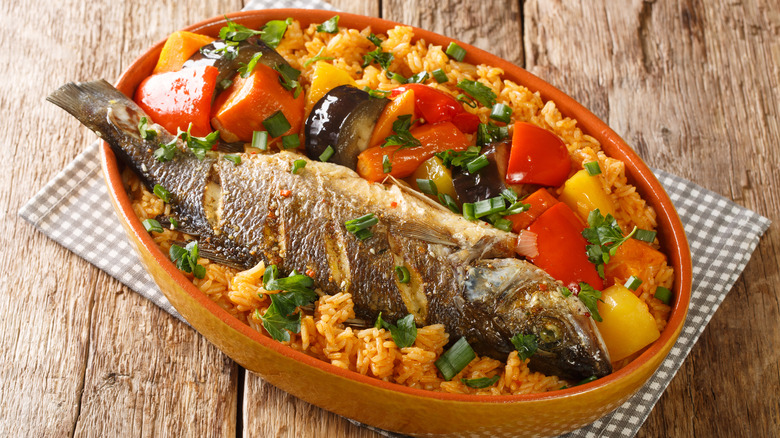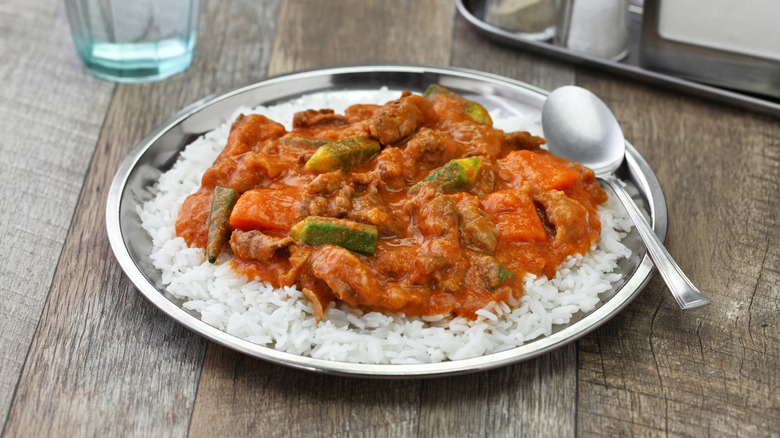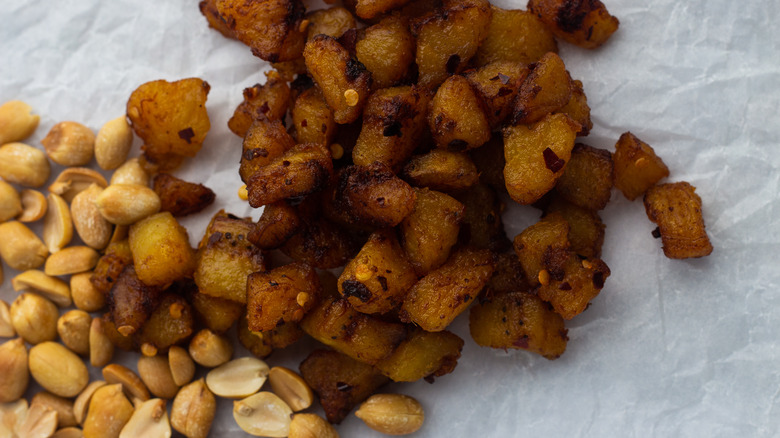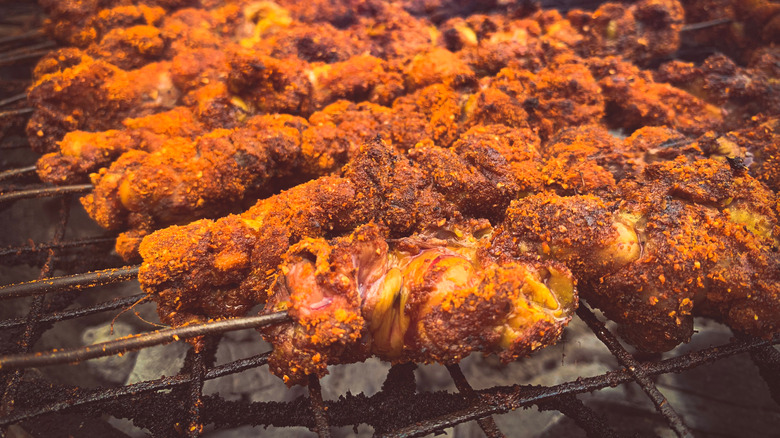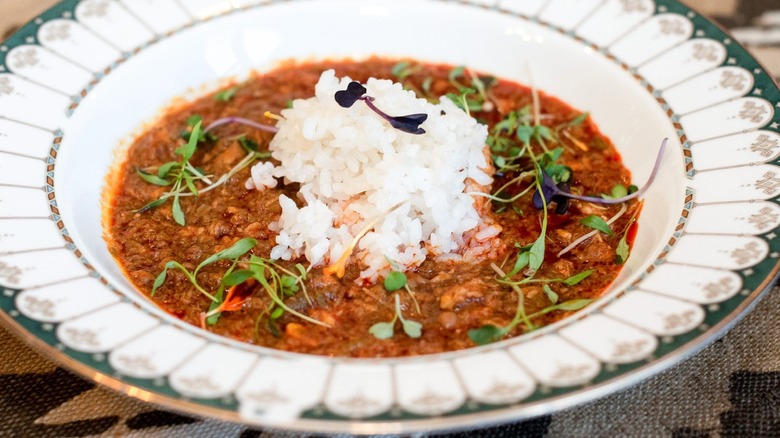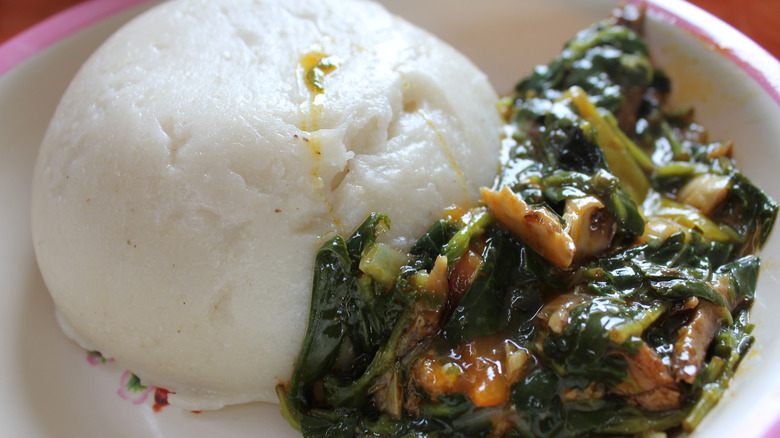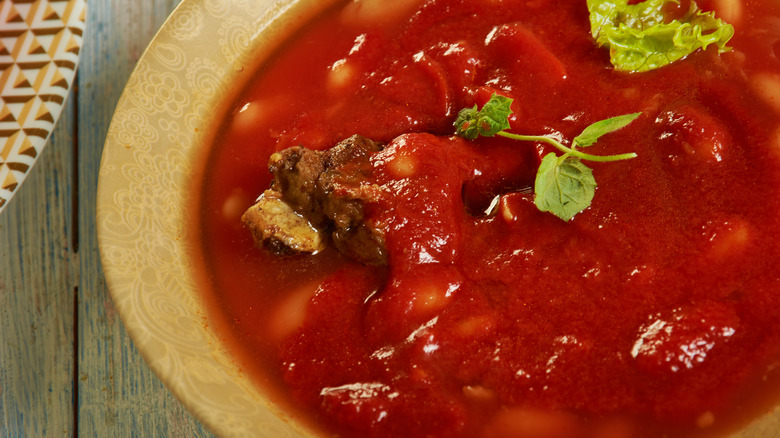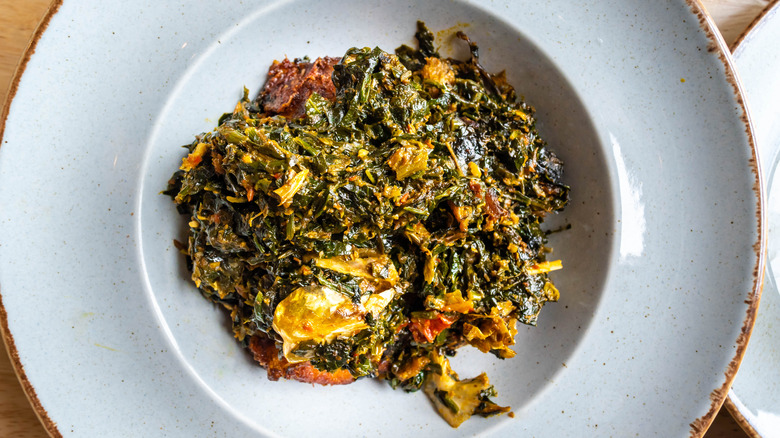12 Traditional West African Dishes You Need To Try At Least Once
West Africa is a large region that includes many countries, including Nigeria, Ghana, Senegal, Mali, and more. As you would expect, there is much diversity in the cuisine of this area, but there are also common ideas that are shared between cooks throughout West Africa. As chef, cookbook author, activist, and food entrepreneur Pierre Thiam put it in an interview with Tasting Table, "food culture transcends the colonial boundaries forced on the region." This list of West African dishes was suggested by Thiam, and it's focused on the cuisine of his home country of Senegal, but many of these recipes are also prepared in varying forms in other West African countries as well. The influence of this cuisine spreads even further than that; colonization, conquest, migration, and slavery brought versions of these dishes from West Africa to Europe, the Americas, and the Caribbean as well.
If you're not lucky enough to lsample Thiam's cooking at the Midtown or Harlem locations of his critically-acclaimed restaurant Teranga, we have good news: In our interview, Thiam gave very detailed instructions on how to prepare these classic West African dishes. We're sure you'll be inspired to try some of these foods in your home kitchen.
1. Fonio
Fonio is a food that Thiam is particularly passionate about, as he sells a variety of fonio products through his company Yolélé, including bagged pilaf mixes and chips. Per Thiam, it is the oldest domesticated grain in Africa, with a history that stretches back over 5,000 years. It's particularly well-suited to cultivation in the arid regions of the continent because it's highly drought-tolerant. This is particularly useful in Senegal, which is experiencing desertification on its border with the Sahara desert. He describes fonio as "the lazy farmer's crop" because it requires so little water, labor, and time to grow. In addition to these benefits, this member of the millet family also helps reintroduce nutrients to the soil.
Fonio isn't just a great crop for farmers; it's also very nutritious. Per Healthline, the grain is packed with B vitamins and also provides iron, protein, fiber, zinc, and more. It's a whole grain and it's gluten-free, so it has certain nutritional advantages over refined starches like white rice and white flour. Its low glycemic index means it can be a good source of starch for diabetic people since it doesn't cause spikes in blood sugar.
From a culinary perspective, fonio has a mild, neutral, and slightly nutty flavor. It can be used in most of the same ways you would use rice. Fonio is a great starchy vehicle for sauces and stews, and Thiam says you can even cook it with sugar and milk to make the fonio equivalent of rice pudding.
2. Caldou
Thiam has childhood memories of his mother preparing caldou; it originated in Southern Senegal where he grew up. It's a brothy fish dish that can be prepared with whole fish, fish filets, or shellfish. Caldou starts with a flavorful base of onions, tomatoes, water, and some kind of fermented fish. In West Africa, it's common to season dishes with fermented dried fish, which adds savoriness, depth, and umami. Since this ingredient is hard to source in North American grocery stores, Thiam suggests substituting it with fish sauce, which has a lot of the same flavor notes. The broth also gets some zest from lemon juice and a whole scotch bonnet pepper, which you leave unbroken so it doesn't make the dish too spicy.
Once you build the broth, you poach the fish in it and finish the dish with some okra. Caldou usually gets a double dose of okra: You cook some into the broth and then serve the finished stew with an okra relish on the side. The relish is traditionally a mixture of okra, sorrel leaves, and fermented fish that's cooked and then blended together into a sauce. If you can't find sorrel leaves, Thiam says a mixture of spinach and lime juice can partially replicate their sour and green flavor.
3. Jollof
While fonio is the traditional starch in some parts of Senegal, the Southern part of the country has a longstanding and influential history of rice cultivation. As Thiam puts it, "Every place in the Americas that you see rice growing culture — North Carolina, South Carolina, Brazil, Jamaica, Mexico — that's the family of rice that came from this region of Senegal."
The most iconic rice dish in West Africa is jollof, which is named after the Jolof Empire that once ruled parts of Senegal. Per Thiam, jollof rice is a simplified descendant of a Senegalese dish called thieboudienne (which we will explain shortly). Despite its Senegalese roots, jollof is now most strongly associated with Nigeria and Ghana, and there are bitter disputes over which country makes the best version.
There are innumerable variations on jollof rice, but the base of the dish is always rice cooked in some kind of flavorful tomato broth. Seasonings change depending on the region but can include spicy chile peppers, smoked paprika, ginger, and thyme. Meat, vegetables, or seafood often join the party as well. It's a festive rice dish fit for a party.
4. Yassa
Yassa is a South Senegalese favorite that is made with chicken, lamb, or fish. The first step for making the spicy, smoky dish is to caramelize a bunch of thinly sliced onions in oil. While the onions are caramelizing, you marinate the protein of your choice in lemon juice, thyme, garlic, salt, and pepper. Once the meat is marinated, it's time to grill. Although this dish can be made on any grill, according to Thiam, the smoky flavor of wood or charcoal adds an important element to this dish's flavor.
Interestingly, you don't cook the meat all the way through on the grill; instead, you just use the grill to sear the meat's exterior and partially cook it. Then you add your par-grilled meat to the caramelized onions. The sweet flavors from the onions mingle with the smoky marinated meat to create a complex interplay of tastes. To finish the dish, add water, lemon juice, and a whole scotch bonnet (again unbroken so it gently perfumes the dish instead of overwhelming it with heat) and allow the yassa to stew until the meat is finished cooking. Like many saucy West African dishes, yassa is typically served up with some kind of grain (either fonio or rice) on the side.
5. Thieboudienne
Now we come to what Thiam describes as "the mother of jollof:" thieboudienne. The name translates to "rice and fish," which is a very simple way of describing what you get in this hearty dish. Like jollof, thieboudienne gets its flavor from a richly-seasoned tomato base. First, you cook tomato, onions, and oil together until they break down into a concentrated, rich paste. Then water or stock and fermented fish or conch are added. This tomato broth becomes a poaching liquid for various types of fresh fish and vegetables. Before going into its hot bath, the fish is coated in a paste made with parsley, ginger, pepper, and scotch bonnets. You cut slits into the fish so that this seasoning paste can penetrate the flesh. Which vegetables are used depends on what you have on hand, but cabbage, carrots, okra, cassava, and eggplant are all traditional.
After the fish and vegetables are done cooking, they're removed from the broth, which is now infused with the flavor of all of these ingredients. Finally, you add rice to this delicious broth. If you properly cook the rice, it should develop a toasted crunchy layer on the bottom of the pan. To serve, you scoop out some rice and top it with the reserved fish and veggies. If you're noticing a similarity to Valencian paella, that's not an accident: per Thiam, Moors from West Africa brought rice to this part of Spain when they conquered the country during the Middle Ages.
6. Maafe
This combination of protein and sauce or stew made from ground peanuts is a traditional dish in several West African countries, including Senegal, Mali, and Nigeria. The easiest way to prepare it is to cook together onions, oil, tomato paste, and peanut butter, though it's commonly made with peanuts that are roasted and then ground by hand. You sauté this mixture while stirring until it comes together into a paste (Thiam insists that a wooden spoon is the only proper stirring tool for Senegalese food). The peanut blend is usually then thinned out with broth and then used to cook some kind of protein like lamb, fish, or chicken, though you can make vegetarian versions as well.
Typical flavorings used in maafe include scotch bonnet peppers and vegetables like cabbage, carrots, or okra. It's served over rice or fonio. Thiam notes that maafe always tastes better the day after you make it, so he suggests preparing a large batch so you can be sure to have leftovers.
7. Kelewele
If you visit street food vendors in Ghana, you're likely to encounter kelewele. It's a fried plantain dish, but it's more complicated than the simple fried plantains you may have seen as a side or appetizer at Caribbean and Latin American restaurants. Kelewele should be prepared with ripe plantains (the sweet ones, not the starchy green ones). The plantains get peeled and diced into small pieces, then tossed with a mixture of grated fresh ginger and cayenne pepper. The plantains need to sit in the seasoning for a while to absorb the flavor, and then they can be deep fried.
If you're making this at home, Thiam stresses that you should fry in small batches so you don't overcrowd the pan. If you prepare too many at once, the plantains will soak up oil and become greasy. The plantain pieces are fried until golden brown. Once cooked, they're often mixed with roasted peanuts to make a craveable street snack.
8. Dibi/Suya
This dish goes by different names depending on where you live (according to Thiam, Dibi is the Senegalese name while Suya is the Nigerian). It's a traditional dish of the Hausa people, who live in parts of many different West African countries.
No matter what you call it, the dish starts with meat, traditionally lamb. The lamb gets cut into thin pieces and then marinated with a mixture of powdered peanuts, dried ginger, chile powder, salt, and pepper. Depending on where it's being prepared, other seasonings can make it into the mix — Thiam says cloves are a fairly common addition. Once the meat has had time to absorb the flavor of the spice mixture, it goes on the grill.
After charring over the flames, the spices harden into a kind of crust on the exterior. As if that weren't enough flavor, the cooked lamb is typically garnished with more powder for dipping and slices of raw onion that you eat alongside the meat. This is another street snack; you eat it on skewers and use a piece of paper as a plate. If you want to make this at home and can't find peanut powder, Thiam says peanut butter will work in the marinade as well.
9. Soupou kanja
Thiam calls soupou kanja "the originator of gumbo." It's an okra dish, and the word "gumbo" is derived from a West African word for okra. This is another recipe that crosses national borders: Soupou kanja is its Senegalese name, while in Nigeria it's simply known as okra stew. Soupou kanja may be prepared with either seafood or meat, or, if you're feeling really fancy, the royal version, which combines surf and turf.
The seafood version of soupou kanja is made with onions, dried fish, water, and a variety of fresh fish and seafood. It uses quite a bit of okra, which is either sliced thin or pounded into a paste and then cooked into the broth. Sometimes smoked catfish is used to give the dish a smoky flavor. Dried oysters can add some savoriness as well.
One of the big differences between a Cajun/Creole gumbo and soupou kanja is that the latter dish uses palm oil, which is a widely used cooking oil in West Africa. Although palm oil is rooted in controversy because of the fact that plantations for the ingredient have contributed to deforestation, Thiam says you can find sustainably sourced palm oil if you know where to look, and he praises its flavor and nutritional profile. The palm oil is stirred into the dish at the end as a finishing touch. Unrefined palm oil gives soupou kanja its red color, while tomatoes are often used to add color to gumbo.
10. Fufu
In Senegal, the typical starch served with saucy dishes is some kind of cooked grain, but in other West African countries, that role is often played by fufu. Fufu may have been invented in Ghana, but it is now popular in many African countries and even in the Caribbean. It's made from cooked starchy vegetables that are pounded until they form a uniform mass. The vegetable can be yuca/cassava, plantains, or yams (note that in this context, we mean true yams, not the orange sweet potatoes often labeled as yams in North America).
To make fufu, you have to laboriously pound the ingredients until they develop an elastic texture that allows them to be formed into round dumplings. The starch is used as both a food and a piece of cutlery. You rip off a piece of the dumpling and form it into a little scoop that you use to pick up the food and sauce it's being served with. Thiam compares fufu to Japanese mochi, which is made using a similar pounding process but with rice as the base instead of cooked starchy vegetables. Thiam notes that some parts of Southern Senegal prepare rice in this way as well.
11. Ndambe
Thiam says, "In Senegal, ndambe is considered to be country people's food." It's filling, hearty, nutritious, and tasty, but it's also a humble dish that often graces the tables of people who don't have a ton of extra money to spend on food.
Ndambe is a stew of black-eyed peas, sweet potatoes, onions, and tomatoes cooked together. If you want to and have the resources for it, meat can be added to flavor the dish (either chicken or lamb). Okra and scotch bonnet chiles can also go into the pot. Like maafe, Thiam advises that this dish tastes a lot better on the second day. It's usually eaten either over cooked grains or with bread on the side for dipping. The next day, the leftovers can even be made into sandwiches. According to Thiam, the history of French colonization in Senegal left the country with a strong baguette culture, and these chewy loaves stuffed with ndambe make for a great breakfast.
12. Efo riro
Efo riro is a dish of slow-cooked or stewed leaves and greens. In Senegal, the traditional greens used for this dish are amaranth leaves. You may know amaranth as a heritage grain with a variety of health benefits, but the plant also produces edible leaves. However, you're not likely to find amaranth leaves in your local supermarket if you live in the States, so that ingredient can be swapped out for other greens like collards, Swiss chard, or spinach. At his restaurant in New York, Thiam makes efo riro with kale.
The type of green doesn't matter very much — the purpose of the dish is to use the leaves of plants that might go to waste otherwise. In other parts of West Africa, cooks might use sweet potato, black-eyed peas, or cassava leaves instead of amaranth. Whatever greens you use, you cut them into ribbons and then cook them with onions, palm oil, tomatoes, and some kind of fermented fish. As with other dishes on the list, there's a connection here to a classic dish from the Southern U.S. In this case, it's Southern-style collard (or mustard, or turnip) greens.
